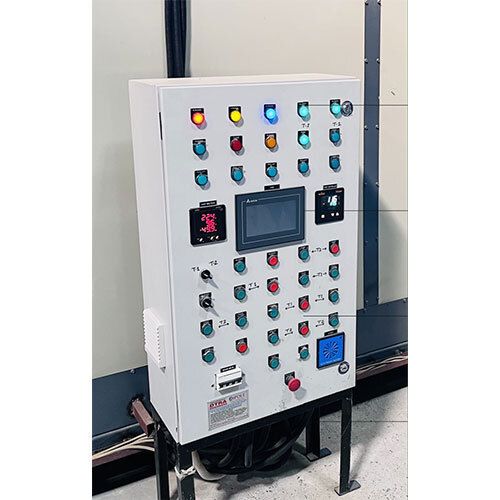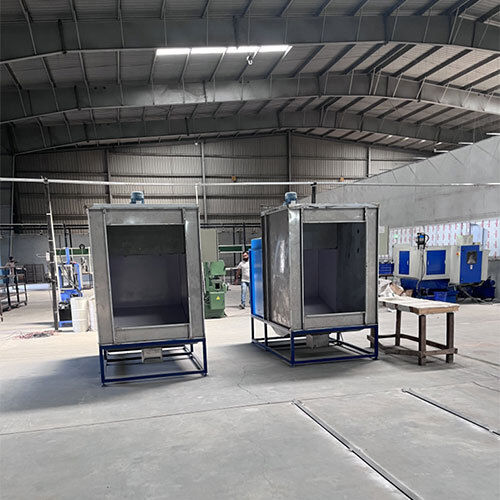Welcome to Our Comapny



Industrial Conveyorised Powder Coating Plant
70,00,000 INR/Unit
Product Details:
- Type Industrial Conveyorised Powder Coating Plant
- Material Stainless Steel
- Computerized No
- Automatic Grade Semi-Automatic
- Control System Frequency Speed Control
- Drive Type Electric
- Click to view more
X
Industrial Conveyorised Powder Coating Plant Price And Quantity
- 70,00,000 INR/Unit
- 1 Unit
Industrial Conveyorised Powder Coating Plant Product Specifications
- Electric
- No
- Frequency Speed Control
- Semi-Automatic
- Stainless Steel
- Industrial Conveyorised Powder Coating Plant
Industrial Conveyorised Powder Coating Plant Trade Information
- 1 Unit Per Month
- 30-90 Days
- All India
Product Description
Industrial Conveyorised Powder Coating Plant is a highly efficient and automated system used for applying powder coatings onto various objects or components in industrial settings. The plant consists of a conveyor system that moves the objects through a series of stages, including pre-treatment, coating, and curing. The objects are pre-treated to remove any contaminants and prepare the surface for coating. They then pass through a powder coating booth where electrostatically charged powder particles are sprayed onto the objects, ensuring even and uniform coverage. The objects are subsequently conveyed through a curing oven where the powder coating is melted and cured, resulting in a durable and high-quality finish. This plant enables large-scale production, increased productivity, consistent coating application, and reduced manual labor, making it an essential component in industrial powder coating operations.
Applications of Industrial Conveyorised Powder Coating Plant:
1. Automotive Industry: Powder coating is widely used in the automotive industry to coat various components such as wheels, bumpers, frames, and chassis parts. It provides a protective layer that enhances the appearance and durability of these parts.
2. Appliances: Household appliances like refrigerators, washing machines, and stoves often undergo powder coating to give them an aesthetically pleasing finish that can withstand daily use and cleaning.
3. Furniture: Metal furniture components like chair frames, table legs, and bed frames are powder coated to provide a durable and scratch-resistant surface. This is especially important for outdoor furniture exposed to weather conditions.
4. Architectural Components: Powder coating is used for architectural components like aluminum window frames, door frames, railings, and fencing. It offers a wide range of colors and textures that can match the overall design of a building.
5. Bicycle Industry: Bicycles and bicycle parts are commonly powder coated due to its durability and resistance to corrosion, which is crucial for outdoor use.
6. Industrial Equipment: Many types of industrial equipment, including machinery, conveyor systems, and storage racks, undergo powder coating to protect them from wear, rust, and chemicals.
7. Electronics Enclosures: Powder coating is used to coat metal enclosures for electronics, providing both protection and an attractive finish.
8. Agricultural Equipment: Farm equipment like tractors, plows, and agricultural machinery often receive powder coating to withstand the harsh conditions of farming environments.
9. Lighting Fixtures: Light fixtures, lamp posts, and outdoor lighting components benefit from powder coatings durability and weather resistance.
10. Medical Equipment: Certain medical equipment and devices are powder coated to ensure they remain hygienic, easy to clean, and visually appealing in clinical settings.
11. Gym Equipment: Exercise equipment in gyms and fitness centers is powder coated to withstand the constant use, sweat, and potential impacts.
12. Store Fixtures: Display racks, shelving units, and store fixtures are coated with powder to create an attractive shopping environment that can withstand heavy use.
13. Metal Shelving and Cabinets: Powder coating is used for metal storage solutions like shelving units and cabinets to make them durable and suitable for various environments.
14. Metal Art and Decor: Powder coating is often used in the creation of metal art and decorative pieces, providing both a protective finish and vibrant colors.
15. Outdoor Recreation Equipment: Playground equipment, park benches, and outdoor signage are frequently powder coated to endure outdoor elements.
16. Consumer Goods: Various consumer goods, such as power tools and garden equipment, can be powder coated to enhance their appearance and functionality.
Advantages of Industrial Conveyorised Powder Coating Plant:
1. Efficiency and High Throughput: Conveyorized systems allow for continuous and automated coating processes, resulting in high throughput and increased production efficiency. Objects move through the coating process seamlessly, reducing downtime between batches.
2. Uniform Coating: The conveyor system ensures consistent and uniform application of powder coating across the entire surface of the object. This leads to a smooth and even finish without streaks, drips, or overspray.
3. Reduced Labor Costs: Automated conveyor systems require fewer operators compared to manual coating methods. This reduces labor costs and the need for extensive training.
4. Higher Quality Finish: Conveyorized powder coating plants enable precise control over application parameters such as powder flow, spray gun movement, and curing conditions. This results in a high-quality, defect-free finish with improved adhesion and durability.
5. Enhanced Adhesion: The electrostatic charge applied to the powder particles during spraying creates a strong attraction to the grounded object, resulting in excellent adhesion. This reduces the chances of chipping, flaking, or peeling of the coating.
6. Reduced Environmental Impact: Powder coating is an environmentally friendly coating method because it does not involve solvents or volatile organic compounds (VOCs). Any excess powder can be collected, recycled, and reused, minimizing waste generation.
7. Wide Range of Colors and Textures: Conveyorized powder coating plants offer a vast selection of colors, finishes, and textures. This allows manufacturers to achieve customized and visually appealing coatings to match various product designs.
8. Resistance to Corrosion and Wear: Powder coatings provide superior resistance to corrosion, chemicals, UV radiation, and abrasion. This makes coated products suitable for outdoor use and harsh environments.
9. Cost-Effective: While the initial investment in setting up a conveyorized powder coating plant may be higher compared to other methods, the long-term cost savings come from reduced labor, minimal waste, and energy-efficient curing processes.
10. Quick Curing Times: Powder coatings can be quickly cured in a controlled oven environment. This results in shorter processing times compared to other coating methods that require longer drying or curing times.
11. Versatility: Industrial conveyorized powder coating plants can handle a wide range of object sizes, shapes, and materials. They are adaptable to various industries, from automotive and furniture to electronics and appliances.
12. Minimal Overspray: The electrostatic attraction of powder particles to the object reduces overspray, leading to efficient powder usage and minimal waste.
13. Ease of Maintenance: Conveyor systems are designed for easy maintenance and cleaning. This ensures smooth operation and consistent coating quality over time.
14. Consistency and Reproducibility: The automated nature of conveyorized powder coating plants ensures consistent results, reducing variability between batches and ensuring that the same quality is achieved every time.
15. Safety and Operator Protection: Automation minimizes direct contact between operators and potentially hazardous materials, improving worker safety.
FAQs of Industrial Conveyorised Powder Coating Plant:
Q. What is an industrial conveyorized powder coating plant?
Ans: An industrial conveyorized powder coating plant is a system used to apply a durable and even powder coating onto various objects through an automated process. The objects are placed on a conveyor that moves them through the stages of powder application, electrostatic charging, curing, and cooling.
Q. How does the powder coating process work in a conveyorized plant?
Ans: The process involves three main stages:
a. Powder Application: Dry powder particles are sprayed onto the surface of the object using a spray gun.
b. Electrostatic Charging: The powder particles are electrostatically charged, creating a strong attraction to the grounded object.
c. Curing: The coated objects are heated in an oven, causing the powder particles to melt, flow, and form a smooth and durable finish.
Q. What are the benefits of using a conveyorized powder coating plant?
Ans: Some benefits include efficient and consistent coating, reduced labor costs, uniform finish, high-quality adhesion, environmentally friendly process (no VOCs), resistance to corrosion and wear, and a wide range of color and texture options.
Q. What types of objects can be coated using this system?
Ans: Conveyorized powder coating plants can coat a wide range of objects, including automotive parts, appliances, furniture, architectural components, industrial equipment, electronics enclosures, medical equipment, and more.
Q. What is the advantage of the electrostatic charge in powder coating?
Ans: The electrostatic charge helps the powder particles adhere evenly to the objects surface due to the attraction between the charged particles and the grounded object. This results in uniform coverage and reduced overspray.
Q. Is powder coating more environmentally friendly than traditional wet painting methods?
Ans: Yes, powder coating is considered more environmentally friendly as it doesnt involve solvents or VOCs. Excess powder can be collected and reused, minimizing waste generation.
Q. How is color selection and customization achieved in powder coating?
Ans: Powder coating plants offer a wide variety of colors and finishes. Manufacturers can choose from a range of pre-made powders or even custom-create powders to match specific color requirements.
Q. Can objects of various sizes and shapes be coated using the same plant?
Ans: Yes, conveyorized powder coating plants are designed to accommodate objects of different sizes, shapes, and materials. The conveyor system can be adjusted to suit the requirements of various products.
Q. What maintenance is required for a conveyorized powder coating plant?
Ans: Regular maintenance includes cleaning spray booths, checking and maintaining spray guns, ensuring proper functioning of the conveyor system, and inspecting curing ovens for consistent temperature.
Q. How does powder coating compare to liquid painting in terms of finish quality?
Ans: Powder coating often provides a more uniform, durable, and resistant finish compared to liquid painting. It is less prone to issues like drips, runs, and inconsistencies in thickness.
Q. Can objects with complex shapes be effectively coated using this method?
Ans: Yes, the electrostatic charge helps powder particles wrap around and coat complex shapes effectively, reaching recesses and corners that might be difficult to reach with traditional painting methods.
Q. What safety measures are important when operating a conveyorized powder coating plant?
Ans: Safety measures include wearing appropriate personal protective equipment (PPE), ensuring proper ventilation to prevent inhalation of powder particles, and adhering to the recommended curing temperatures to avoid potential hazards.
Q. What are some industries that commonly use conveyorized powder coating plants?
Ans: Industries such as automotive, appliances, furniture, architecture, electronics, industrial equipment, medical equipment, and outdoor recreation often utilize conveyorized powder coating plants.
Q. Is there a limit to the thickness of the powder coating layer that can be applied?
Ans: Yes, there is a limit to the thickness to ensure proper curing and adhesion. The coating thickness is controlled by factors like the powders particle size and the application process.
Q. Can conveyorized powder coating plants be automated further using robotics or AI?
Ans: Yes, some advanced setups incorporate robotics and automation to handle intricate coating processes, monitor quality, and adjust parameters for optimal results.
FAQs of Industrial Conveyorised Powder Coating Plant:
Q: What is the type of Industrial Conveyorised Powder Coating Plant?
A: The type of Industrial Conveyorised Powder Coating Plant is mentioned in the product name itself.Q: Does this product have a computerized control system?
A: No, the product is not computerized.Q: What material is used to manufacture this product?
A: Stainless Steel is used to manufacture this product.Q: What is the control system used in this product?
A: Frequency Speed Control is the control system used in this product.Q: What is the automatic grade of this product?
A: The automatic grade of this product is semi-automatic.Q: What is the drive type used in this product?
A: Electric is the drive type used in this product.Q: Can this product be customized as per customer requirements?
A: The product specifications mentioned are the standard specifications. However, customization can be done based on specific customer requirements.Enter Buying Requirement Details








 Call Me Free
Call Me Free
 English
English Spanish
Spanish French
French German
German Italian
Italian Chinese (Simplified)
Chinese (Simplified) Japanese
Japanese Korean
Korean Arabic
Arabic Portuguese
Portuguese